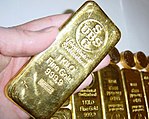


Economic extraction can be achieved from ore grades as little as 0.5 g/1000 kg (0.5 parts per million, ppm) on average in large easily mined deposits. Typical ore grades in open-pit mines are 1–5 g/1000 kg (1-5 ppm), ore grades in underground or hard rock mines are usually at least 3 g/1000 kg (3 ppm) on average. Since ore grades of 30 g/1000 kg (30 ppm) are usually needed before is visible to the naked eye, in most mines the is invisible.
Since the 1880s, South Africa has been the source for a large proportion of the world’s supply. Production in 1970 accounted for 79% of the world supply, producing about 1,000 tonnes. However, production in 2005 was just 294 tonnes according to the British Geological Survey. This sharp decline was due to the increasing difficulty of extraction and changing economic factors affecting the industry in South Africa.
The city of Johannesburg was built atop the world's greatest finds. fields in the Free State and Gauteng provinces are deep and require the world's deepest mines. The Second Boer War of 1899–1901 between the British Empire and the Afrikaner Boers was at least partly over the rights of miners and possession of the wealth in South Africa.
Other major producers are United States, Australia, China and Peru. Mines in South Dakota and Nevada supply two-thirds of used in the United States. In South America, the controversial project Pascua Lama aims at exploitation of rich fields in the high mountains of Atacama Desert, at the border between Chile and Argentina. Today about one-quarter of the world output is estimated to originate from artisanal or small scale mining.[7]
After initial production, is often subsequently refined industrially by the Wohlwill process or the Miller process. Other methods of assaying and purifying smaller amounts of include parting and inquartation as well as cuppelation, or refining methods based on the dissolution of in aqua regia.
The world's oceans hold a vast amount of , but in very low concentrations (perhaps 1-2 parts per billion). A number of people have claimed to be able to economically recover from sea water, but so far they have all been either mistaken or crooks. Reverend Prescott Jernegan ran a -from seawater swindle in America in the 1890s. A British fraud ran the same scam in England in the early 1900s.[8]
Fritz Haber (the German inventor of the Haber process) attempted commercial extraction of from sea water in an effort to help pay Germany's reparations following the First World War. Unfortunately, his assessment of the concentration of in sea water was unduly high, probably due to sample contamination. The effort produced little and cost the German government far more than the commercial value of the recovered. No commercially viable mechanism for performing extraction from sea water has yet been identified. synthesis is not economically viable and is unlikely to become so in the foreseeable future.
The average mining and extraction costs are $238 per troy ounce but these can vary widely depending on mining type and ore quality. In 2001, global mine production amounted to 2,604 tonnes, or 67% of total demand in that year. At the end of 2001, it was estimated that all the ever mined totalled 145,000 tonnes.[9]
(Source : wikipedia.org)


No comments:
Post a Comment